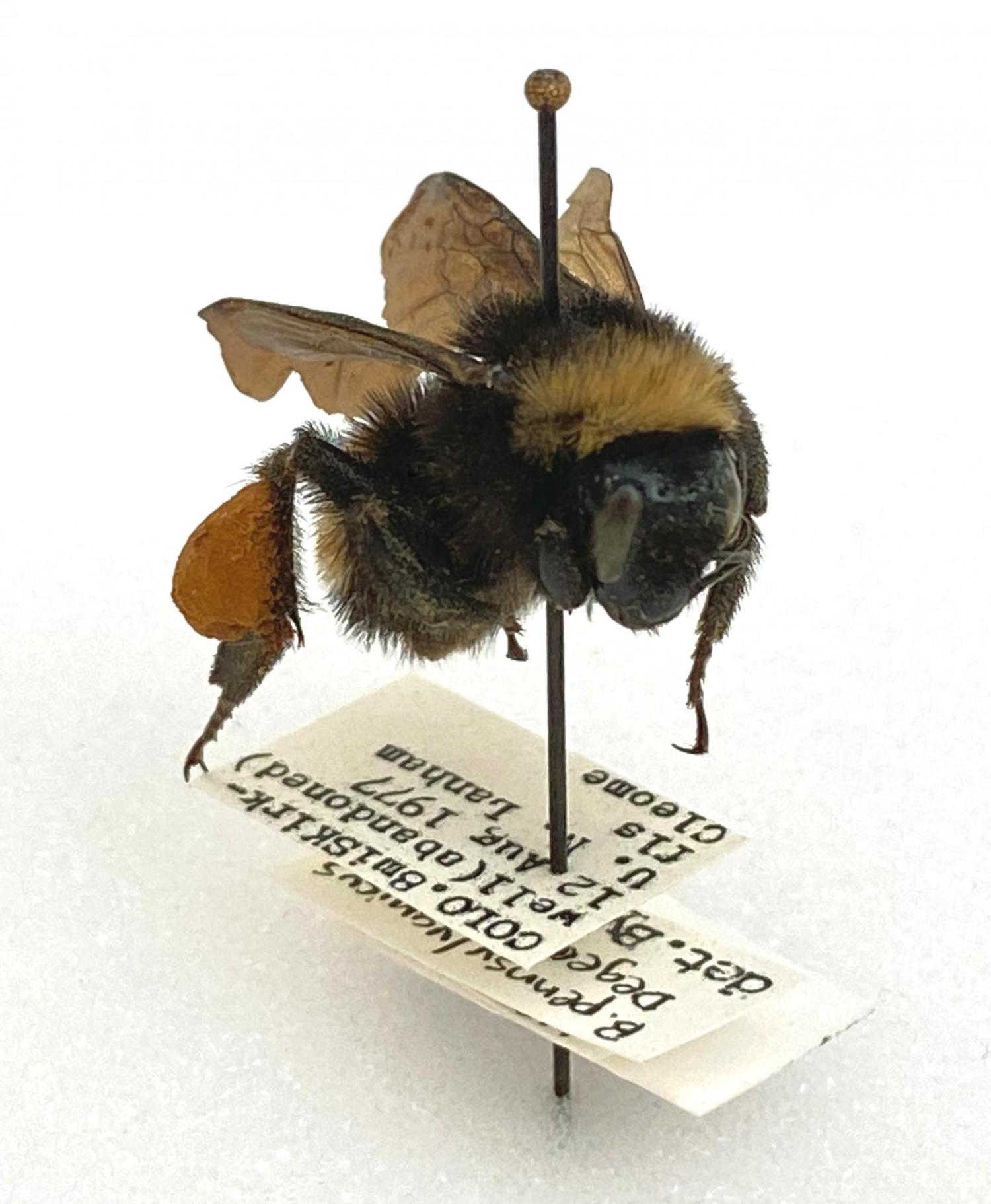The CU Museum is closed we will be opening early in the spring semester.
During this time, collection visits will be available by appointment and other special access requests will be considered on a case-by-case basis.
Please email cumuseum@colorado.edu for more information.
American Bumble Bee
The American Bumble Bee, Bombus pensylvanicus, is one of the most common bumble bee species found on the Front Range and is one of the 24 species found in Colorado1. This species is found only in the lower elevations of the state (3500-5500 feet above sea level) and its range is one of the greatest for all North American bumble bees stretching from the grasslands east of the Rocky Mountains all the way to the coastal Atlantic states, north into Canada and south into Mexico2.
Bumble bees are social insects, meaning they have a queen, worker, and male caste. The colony cycle is annual, meaning only new queens survive the winter after mating. In the early spring, queen bumble bees wake up from their winter slumber and begin collecting pollen and nectar and to seek a suitable nest site. Most bumble bees nest underground, usually in abandoned rodent holes. At the chosen nest site, the queen will create ball of pollen from her collections and coat it with a wax she secrets from her abdomen, which keeps pollen from dehydrating. After she is satisfied with this pollen ball, she lays eggs on top and will rarely leave the nest again. She rests on top of the pollen ball to incubate her young as they pass through a larval and pupal stage. After about two weeks of incubation, adult workers will emerge from the nest. Aside from their smaller size, workers generally look identical to their mother. As the queen continues to lay eggs, the workers are now in charge of collecting pollen and nectar for their future sisters, and eventually brothers. The queen is in control of which types of eggs she lays and in mid- to late summer, the queen will lay male and queen eggs. New males and queens are not welcome to stay in the nest for long and will quickly leave the nest. Shortly after a male mates with a new queen, he will die and the queen will find another place underground to spend the winter. American bumble bee colonies will produce about 130 workers and 33 queens throughout the annual colony cycle3. Aside from the parasitic bumble bee species, this life cycle is very similar for bumble bees around the world.
Like many bumble bees, the American bumble bee is in decline. It was formally listed as a vulnerable species on The IUCN Red List of Threatened Species in 20154. Through consulting museum records and citizen science monitoring of this species from collections around the world, it is estimated that the American bumble bee has lost 23% of its native range and is significantly less abundant than it has been in the past4. In addition to habitat loss and climate change, this significant decline has been linked to a fungal parasite, Nosema bombi. It has been proposed that this pathogen was introduced to wild bumble bee populations from commercially managed colonies used for tomato pollination in greenhouses5. Despite the vast population decline on most of the continent, the American bumble bee persists in Colorado, at least for now.
Common name: American Bumble Bee
Scientific name: Bombus pensylvanicus (Family: Apidae)
Catalog number: UCMC 0081311
Label data: Colorado 8 miles South of Kirkwell (abandoned); 12 August 1977; U.N. Lanham; at flowers of Cleome
1. Wright, A., Boyd, C.L., Bowers, M.D., and Scott, V.L., 2017. The Bumble Bees of Colorado.
2. MacPhail, V.J., Richardson, L.L., and colla, S.R., 2019. Incorporating citizen science, museum specimens, and field work into the assessment of extinction risk of the American Bumble Bee (Bombus pensylvanicus, De Geer 1771) in Canada. Journal of Insect Conservation, 23(3), 597-611.
3. Macfarlane, R.P., Patten, K.D., Royce, L.A., Wyatt, B.K.W., and Mayer, D.F., 1994. Management potential of sixteen North American bumble bee species. Melanderia, 50, 1-12.
4. Hatfield, R., Jepsen, S., Thorp, R.W., Richardson, L.L., Colla, S.R., and Foltz Jordan, S., 2015. Bombus pensylvanicus (e. T21215172A21215281). International Union for Conservation of Nature.
5. Cameron, S.A., Lozier, J.D., Strange, J.P., Koch, J.G., Cordes, N., Solter, L.F., and Griswold, T.L., 2011. Patterns of widespread decline in North American bumble bees. Proceedings of the National Academy of Sciences, 108(2), 662-667.


